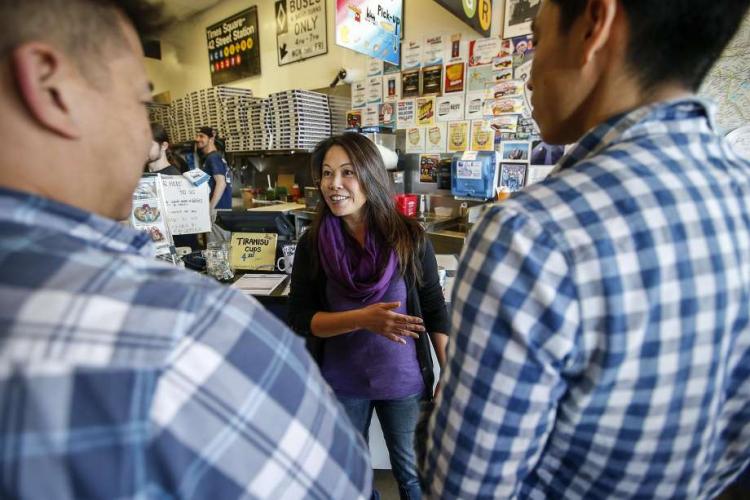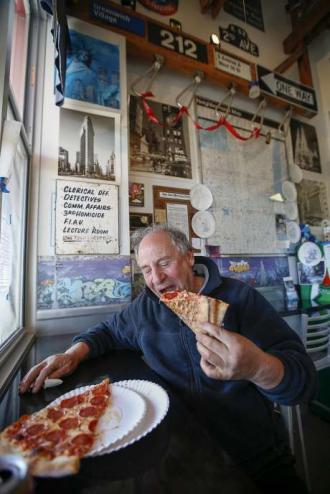Employee Ownership May Help Businesses Stay Open




Working at a pizza shop isn’t usually a career move.
Converting businesses like A Slice of New York to an employee-ownership model has many advantages, according to Oakland nonprofit Project Equity, which was founded three years ago to help business owners discern which kind of employee-ownership model would work best and then assist with the transition.
It increases the likelihood that the business will stay locally owned and operated, gives workers a greater equity and turns what might otherwise be a low-paying blue-collar job into a more rewarding career, nonprofit co-founder Hilary Abell said.
It may also be a solution to a growing problem facing the Bay Area: Baby Boomers own nearly half the privately held businesses that have employees, and every year, nearly 4 million Boomers across the nation retire.
Project Equity estimates that about 63,640 businesses across the nine Bay Area counties are owned by Baby Boomers. These businesses are responsible for about 625,900 employees and bring in about $149.5 billion in revenue every year, according to estimates based on U.S. Census data.
Boomers, generally considered those born between 1946 and 1964, are retiring at unprecedented rates; the government estimated in 2013 that more than 10,000 retire every day.
Despite this, more than 85 percent of business owners do not have a succession plan for who will take over their business when they no longer want to, or are able to, run the company, according to a report published Friday by Project Equity.
Selling isn’t always an option. In fact, only about 20 percent of small businesses that list themselves for sale actually find a buyer. And those that do may be acquired by a bigger company or out-of-area buyer.
Passing a small business on to family members is possible — about 15 percent of small-business owners do it — though not always viable. So in many cases, companies simply close.
“A common misconception we hear from business owners is they don’t think their business could run that way or that they don’t think their employees could run the business like they do,” said Project Equity co-founder Alison Lingane. “But it’s not always as big a shift as people think. It’s a shared form of entrepreneurship. Not every single person needs to be able to do the things we think of as roles for an entrepreneur or an owner.”
Not all small businesses are equipped or ideal for conversion into an employee-owned business. For some, stability can be an issue. Project Equity does not recommend making the transition until or unless a business is stable and profitable. For low-wage workers, coming up with the money to buy into a business can be a challenge. And lenders can also be wary of offering loans to businesses seeking to transition into an employee-owned operation as it is a less traditional form of financing than a loan to a singular business owner.
There are several types of employee-owned businesses, including the co-op and an employee stock-ownership plan.
A worker cooperative, like the kind A Slice of New York is striving to become, is a business in which each member of the co-op has one equal share and one equal vote in business decisions.
Co-ops are also known for their pay equity, since many institute a pay scale that sets strict guidelines for a pay ratio to ensure the highest-paid person does not make an exorbitant amount more than the lowest-paid. Worker-owners also divide up what is known as patronage, or the co-op’s profits at the end of each year.
For workers at A Slice of New York, they will start to receive patronage after a two-year commitment, owner Kirk Vartan said. Each will be asked to put up $6,500 to buy a portion of the business.
Stock plans are different, though can also be structured to allow employee-owners to have a democratic say in the business.
An outside entity, like a trust, would acquire a portion of a company’s stock and hold it for the benefit of the employees. That means that employees would earn shares of the company within the trust and then receive a payout when they leave.
There are several well-known co-ops in the Bay Area, including the Arizmendi Bakery chain. This helps raise awareness, though many owners still do not see how their business could transform into a worker-owned model, Lingane and Abell said.
But with the rising cost of living in the Bay Area, worker-owned businesses may actually give workers the greatest chance at staying employed and staying in the area, Abell added.
“I’ve lived in Oakland for about 20 years, and in that time the black population of Oakland has decreased in a huge way — by around 40 percent,” she said. “Seeing that and the way that the racial wealth gap keeps getting wider. … Employee ownership is a way to reward and validate the work of low-wage workers, and to help them stay in place, stay in the community.”
When Vartan and his wife and co-owner, Marguerite Lee, opened their original pizzeria on Stevens Creek Boulevard in San Jose, they wanted to open it as a co-op. But at the time it was too complicated, they said. Neither had experience opening a restaurant — they had both left jobs at Cisco Systems.
In the years since, they’ve cultivated an environment that is more of a family than a business.
Vartan and Lee don’t have any kids of their own, but their employees give Lee hugs before they leave for the day and invite the two to see their bands perform. They call Lee “Mom,” and tease Vartan about the way he uses his cell phone. More than a dozen workers have even tattooed the pizzeria’s New-York skyline logo onto their bodies. They call it the “family crest.”
The business, Lee said, already runs much like a co-op. The employees can make their own decisions. When the restaurant does well, they get bonuses.
In a few months, it officially will become one, with Vartan and Lee stepping back into equal roles as the employees they work alongside.
“I don’t see the difference between blood and friends, and these are guys we’d do whatever for,” Vartan said. “This is our chosen family. And by doing something that will help them, we also get to lead this effort and bring (a worker-owned business) to the South Bay. This is how we change our social dynamics here. We’re excited to lead the way.”
Marissa Lang is a San Francisco Chronicle staff writer. Email: [email protected] Twitter: @Marissa_Jae
Photos by Tony Avelar, Special To The Chronicle – February 17, 2017
Pizzeria co-owner Marguerite Lee talks with customers during lunch.
Jonathon Rangel tosses some pizza dough at A Slice of New York in San Jose as Miguel Rubio puts the topping on the pizza. The pizzeria is in the process of transitioning from a traditional ownership structure to a cooperative.
Hilary Abell (left) and Alison Lingane stand near their Project Equity office in Oakland. Their organization helps small, locally owned businesses figure out employee ownership strategies.
David Aleshi takes a bite of a pepperoni pizza during lunch at A Slice of New York pizzeria in San Jose. The New York-style pizzeria is in the process of transitioning from a traditional owner structure to a cooperative that will create a democratic governance system with 10 employees becoming co-owners of the business.







